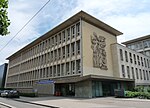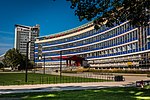University of Strasbourg

The University of Strasbourg (French: Université de Strasbourg, Unistra) is a public research university located in Strasbourg, Alsace, France, with over 52,000 students and 3,300 researchers.The French university traces its history to the earlier German-language Universität Straßburg, which was founded in 1538, and was divided in the 1970s into three separate institutions: Louis Pasteur University, Marc Bloch University, and Robert Schuman University. On 1 January 2009, the fusion of these three universities reconstituted a united University of Strasbourg. With as many as 19 Nobel laureates, and two Fields Medal winners, the university is ranked among the best in the League of European Research Universities.
Excerpt from the Wikipedia article University of Strasbourg (License: CC BY-SA 3.0, Authors, Images).University of Strasbourg
Boulevard de la Victoire, Strasbourg Esplanade
Geographical coordinates (GPS) Address Nearby Places Show on map
Geographical coordinates (GPS)
| Latitude | Longitude |
|---|---|
| N 48.580277777778 ° | E 7.7644444444444 ° |
Address
Campus Centre
Boulevard de la Victoire
67091 Strasbourg, Esplanade
Grand Est, France
Open on Google Maps









